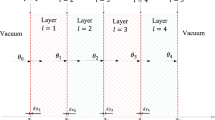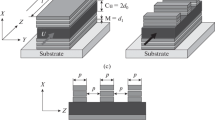Abstract
Simulation of the electrical and optical response of a multilayer thin film composed of lossless material coupled with adjacent lossy material in an alternating arrangement when applying a transverse voltage across the multilayer thin film is conducted using a polynomial approach. The modelling of the lossy–lossless multilayer thin film is a generalization of our previous work on multilayer thin film made up of alternating lossy–lossy materials. It is the propagation matrix of the electromagnetic wave in the thin film that governs its propagation, while the interface matrix represents the coupling between layers at an interface. The present solution models the multilayer thin film as an effective capacitor constructed from a series of coupled capacitors, with every layer being considered as a capacitor coupled to the next. A transverse voltage can affect the amounts of electric charges that accumulate at the interface between adjacent ‘capacitors’. The present model is constructed to describe nonmagnetic, lossy and lossless materials. With the aid of a home-developed code implementing the model, the reflection and transmission of multilayer Ge/MgO thin films are simulated. By tuning the transverse electric potential, geometrical and electrical parameters of an arbitrary lossy–lossless multilayer thin film, the code is capable of predicting nontrivial optical responses in terms of \(T\left(\lambda \right), R\left(\lambda \right), {\phi }_{T}\left(\lambda \right), {\phi }_{R}(\lambda )\). The code can serve as a useful tool for designing and optimizing lossless-lossy or lossless-lossless multilayer thin films to deliver desired optical functions.





















Similar content being viewed by others
Data Availability
The refractive index of Germanium and Magnesium Oxide can be accessed by visiting and searching the database on the following website: acquired by K. company Filmetrics, “No Title refractive index data for common materials.” https://www.filmetrics.com/refractive-index-database. The electrical resistivity of Germanium can be found on the following website: https://periodictable.com/Elements/032/data.html. The dielectric constant of Germanium can be found on the following website: https://eesemi.com/sigegaas.htm. The electrical resistivity of Magnesium Oxide can be found in the reference (Yamaka and Sawamoto 1954). The dielectric constant of Magnesium Oxide can be found on the following website: https://www.crystran.co.uk/optical-materials/magnesium-oxide-mgo
References
Acquired by K. company Filmetrics, No Title refractive index data for common materials. https://www.filmetrics.com/refractive-index-database
Azzam, R.M.A., Bashara, N.M.: Ellipsometry and polarized light. North-Holland Pub. Co., Newyork (1977)
Clinard, F.W., Jr., Hurley, G.F., Hobbs, L.W.: Neutron irradiation damage in MgO, Al2O3 and MgAl2O4 ceramics. J. Nucl. Mater. 108, 655–670 (1982)
Crystran Ltd - World Wide Optics Source, “MgO dielectric constant.” https://www.crystran.co.uk/optical-materials/magnesium-oxide-mgo
Dressel, M., Gruner, G., Grüner, G.: Electrodynamics of Solids: Optical Properties of Electrons in Matter. Cambridge University Press, Cambridge (2002)
Dunlap, W.C., Jr., Watters, R.L.: Direct measurement of the dielectric constants of silicon and germanium. Phys. Rev. 92(6), 1396 (1953)
El-Agez, T., Taya, S., El Tayyan, A.: A polynomial approach for reflection, transmission, and ellipsometric parameters by isotropic stratified media. Opt. Appl 40, 501–510 (2010)
Elhabbash, M.K.M., Halim, M.M., Yoon, T.L.: A polynomial model of transmission and reflection of electromagnetic monochromatic plane waves in lossless, non-magnetic multilayer thin films subjected to an external transverse voltage. Opt. Quantum Electron. 53(2), 1–29 (2021)
Elhabbash, M. K. M.: WaveTensor-I, https://github.com/Melhabbash/WaveTensor-I. (2022)
Elhabbash, M. K. M.: Wavetensor-II-Lossy. https://github.com/Melhabbash/WaveTensor-II-Lossy--Ge-MgO. (2022)
https://periodictable.com/, Germanium Electrical Resistivity.” https://periodictable.com/Elements/032/data.html
https://www.EESemi.com, “Germanium (Ge), dielectric constant.” https://eesemi.com/sigegaas.htm
Grossel, P., Vigoureux, J.M., Baida, F.: Nonlocal approach to scattering in a one-dimensional problem. Phys. Rev. A 50(5), 3627 (1994)
Jackson, J.D.: Classical electrodynamics, 3rd edn. Wiley, United States of America (1998)
Khorasani, S., Rashidian, B.: Guided light propagation in dielectric slab waveguide with conducting interfaces. J. Opt. A Pure Appl. Opt. 3(5), 380 (2001)
Knittl, Z.: Optics of thin films: an optical multilayer theory. Wiley, Newyork (1976)
Kwak, J.H., Hong, S.: Linear algebra. Birkhäuser Boston, Boston (2013)
Larson, R., Falvo, D.C.: Elementary linear algebra. Brooks/Cole Cengage Learning, Boston (2008)
Lewis, T.J., Wright, A.J.: The electrical conductivity of magnesium oxide at low temperatures. J. Phys. D. Appl. Phys. 1(4), 441 (1968)
Markos, P., Soukoulis, C.M.: Wave propagation: from electrons to photonic crystals and left-handed materials. Princeton University Press, Newjersey (2008)
Pozar, D.M.: Microwave Engineering. Wiley, Newyork (2012)
Putley, E.H.: The electrical conductivity of germanium. Proc. Phys. Soc. Sect. A 62(5), 284 (1949)
Shabat, M.M., Taya, S.A.: A new matrix formulation for one-dimensional scattering in dirac comb (electromagnetic waves approach). Phys. Scr. (2003). https://doi.org/10.1238/physica.regular.067a00147
Stratton, J.A.: Electromagnetic Theory. Wiley, Newyork (2007)
Strelniker, Y. M., Bergman, D. J.: Gate-tuning of the surface plasmons and their optical properties, In: Plasmonics: Design, Materials, Fabrication, Characterization, and Applications XX, 12197, 1219706, (2022)
Taya, S.A., El-Agez, T.M.: Ellipsometry of anisotropic materials: a new efficient polynomial approach. Optik (stuttg) 122(8), 666–670 (2011). https://doi.org/10.1016/J.IJLEO.2010.05.002
Vigoureux, J.-M.: Polynomial formulation of reflection and transmission by stratified planar structures. J. Opt. Soc. Am. 8, 1697 (1991)
Wang, S.: Fundamentals of semiconductor theory and device. Prentice hall englewood cliffs, NJ (1989)
Yamaka, E., Sawamoto, K.: Electrical conductivity of magnesium oxide single crystals. Phys. Rev. 95(3), 848 (1954)
Funding
Not applicable.
Author information
Authors and Affiliations
Contributions
MM Halim and TLeong Yoon supervised the project and encouraged MKM Elhabbash to investigate " non-magnetic lossy multilayer thin films subjected to an external transverse voltage" and supervised the findings of this work. MKM Elhabbash conceived the presented idea, developed the theory, and performed the computations and simulations. TL Yoon and MKM Elhabbash verified the analytical methods. MKM Elhabbash wrote the manuscript with the support and supervision of TL Yoon and SA Taya. SA Taya checked the manuscript's plagiarism status, and MKM ElHabbash paraphrased it. All authors discussed the results and contributed to the final manuscript.
Corresponding authors
Ethics declarations
Competing interests
The authors declare no competing interests.
Conflict of interest
The authors declare that they have no known competing financial interests or personal relationships that could have appeared to influence the work reported in this paper.
Appendix flowchart and pseudocode of the wave tensor code
See Fig. 22.
Additional information
Publisher's Note
Springer Nature remains neutral with regard to jurisdictional claims in published maps and institutional affiliations.
Rights and permissions
Springer Nature or its licensor (e.g. a society or other partner) holds exclusive rights to this article under a publishing agreement with the author(s) or other rightsholder(s); author self-archiving of the accepted manuscript version of this article is solely governed by the terms of such publishing agreement and applicable law.
About this article
Cite this article
Elhabbash, M.K.M., Halim, M.M., Yoon, T.L. et al. A polynomial model of transmission and reflection of electromagnetic monochromatic plane waves in lossy, non-magnetic multilayer thin films subjected to an external transverse voltage. Opt Quant Electron 55, 214 (2023). https://doi.org/10.1007/s11082-022-04468-z
Received:
Accepted:
Published:
DOI: https://doi.org/10.1007/s11082-022-04468-z





